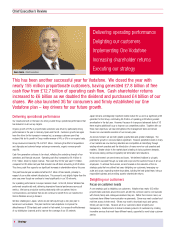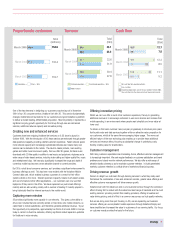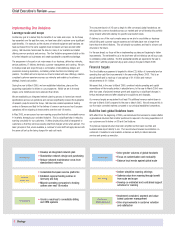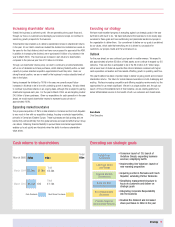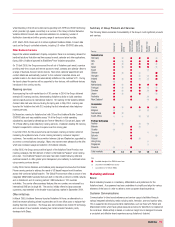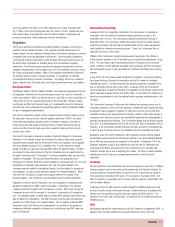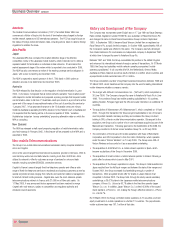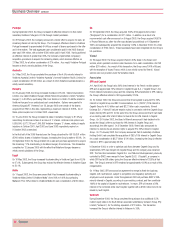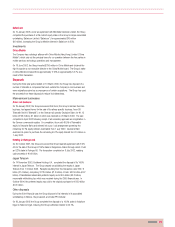Vodafone 2005 Annual Report Download - page 18
Download and view the complete annual report
Please find page 18 of the 2005 Vodafone annual report below. You can navigate through the pages in the report by either clicking on the pages listed below, or by using the keyword search tool below to find specific information within the annual report.
Business Overview continued
16 |Business
Customer Strategy and Management
During the year, Vodafone implemented a system for measuring ‘customer delight’
across all the Group’s customers at a local and global level. This will assist in the
development of differentiated marketing propositions and programmes that drive
revenue growth.
Vodafone has developed strategies to ensure that the outcome of customer
interactions, whether via call centres or retail outlets, results in a level of sustainable
differentiation delivering ongoing value and customer loyalty to Vodafone.
Distribution
The Group distributes its products and services through a wide variety of direct and
indirect channels, with different approaches used in the consumer and business
sectors.
Products and services are available directly to both consumer and business customers
in the majority of markets. Nearly 1,000 stores are directly owned and managed by
Vodafone, with an additional 4,600 Vodafone branded stores making Vodafone one of
the largest global retailers. In addition, local websites offer products and services
online and local sales forces are in place to discuss terms with business customers.
The extent of indirect distribution varies between markets, but may include using third-
party service providers, independent dealers, agencies and mass marketing. Marketing
to third-party service providers includes maintaining a competitive tariff structure,
providing technical and other training to their staff and providing financial incentives for
service providers, their dealers and sales people. It also entails providing assistance on
advertising campaigns and supporting the development of both specialist retail outlets
and programmes with multiple retailers.
During the year, Vodafone set up a global IT distribution channel by entering into a
partnership with two leading global IT distributors. This will be an effective channel for
Vodafone to access a wider number of business customers and sell mobile data
products and services.
The last few years have seen the growth of MVNOs who buy access to existing
networks and re-sell services to customers under a different brand name and
proposition. Where such a relationship generates profitable use of network capacity
and does not impact the Vodafone brand, a mobile operating subsidiary may consider
entering into a partnership with an MVNO.
Multinational corporates
Vodafone currently provides products and services to over 200 of the world’s largest
companies on a global basis. The first global Customer Advisory Board, which allows
global customers to participate actively in driving Vodafone’s strategy for business, took
place in February 2004, with the second meeting in September 2004.
A new “Multinational Corporates”business unit was established on 1 April 2005 to
focus on providing end-to-end differentiated propositions and consistent, world-class
service to Vodafone’s Multinational Corporate customers. The new business unit will
aim to ensure consistent delivery across Vodafone’s markets for product offerings,
customer service and pricing, underpinned by first-rate account management.
Research and development
The Group Research and Development (“R&D”) function comprises an international and
multicultural team for applied research in mobile telecommunications and its
applications. The majority of the Group’s R&D function is undertaken through the
Group’s centres of excellence, located in Newbury, Maastricht, Munich, California, Milan,
Tokyo and Madrid. In the 2005 financial year, the R&D function in the Group’s
associated undertaking in France, SFR, started working with Group R&D as an associate.
Group R&D provides technical leadership, and a programme of research support, into
technology that will typically start to be used in the business in three years and beyond.
Governance is provided by the Group R&D Board which is chaired by the Group R&D
Director and consists of the chief technology officers from four of the mobile operating
subsidiaries, together with the heads of Future Products, Business Strategy and
Technology Development.
Group R&D focuses on applied research that is positioned between the basic research
undertaken by universities and commercial product development. Since the Group is
primarily a user of technology, the emphasis of the Group R&D work programme is on
providing technology analysis and vision that can contribute directly to business
decisions, enabling new applications of mobile telecommunications, using new
technology for new services, and research for improving operational efficiency and
quality of the Group’s networks. The work of the function is organised into three
clusters: future vision and opportunity, technology research and application research.
The first cluster is concerned with expanding business boundaries through advances in
technology, science and business practice, providing input to the Group’s strategy. The
second cluster is concerned with core radio, network and service enabling
technologies. It includes business modelling techniques, application of social science
and analysis of disruptive technologies. The third cluster is concerned with developing
new business applications of radio based technologies for commercial launch.
The work of Group R&D is delivered through a series of programmes with a substantial
portion of trials and demonstrations. All work is set in a business and social context.
Group R&D provides leadership for funding research into health and safety aspects of
mobile telecommunications, technical leadership for the Group’s spectrum strategy and
technical leadership for the protection of intellectual property, including the Vodafone
patent portfolio.
The main themes currently being researched are technologies that will follow the
evolution of 3G. The basis of the Group’s 3G radio technology is W-CDMA and this is
expected to evolve to a higher speed version, usually referred to as HSDPA or HSUPA.
New underlying radio technologies, beyond the current generations, are also being
evaluated. Evolutions to the core network based on ubiquitous use of Internet protocols
and web services complement this, and are likely to lead to a convergence of Internet
and mobile technologies. Significant R&D is also being undertaken on mobile TV,
including schemes for managing content rights. Applications of mobile
telecommunications to health and well being are being researched in collaboration with
a chair at the University of Madrid funded through the local Vodafone foundation and
for more information on Vodafone’s work in health and well being, see the 2005 report
from the Vodafone Group Foundation titled “The Foundations, Investing in communities
and the environment”. Applications to transport management are also being
researched. Key to much of the research is the need to ensure that when there is a
customer proposition that demands new technology, then this can be introduced with
the minimum of cost, for example by using existing investment in sites and spectrum.
Much of the work of Group R&D is done in collaboration with others, both within the
Group and externally. Joint R&D facilities have been set up with three major
infrastructure suppliers. Infrastructure and handset suppliers work with Group R&D on
many of its projects, from providing equipment for trials, through co-authoring research
reports, to being a partner in some of the R&D programmes. At the more academic
end of the spectrum of applied research, Group R&D has developed relationships with
a number of universities. These relationships include sponsoring research students,
collaboration in European research activities, funding specialised research activities and
working with academic chairs and readerships funded through the Vodafone Group
Foundation.
The R&D programme provides the Group with long-term technical policy, strategy and
leadership, as well as providing technical underpinning for the Group’s public policies
and government relations, and is shared with all subsidiaries of the Company and
Group functions. They are able to influence the programme through working
relationships that are designed to allow delivery of the results of the programme
directly into the business units where they are needed.


